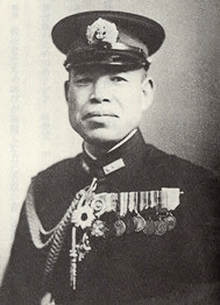Seiichi Itō
Seiichi Itō (伊藤 整一, Itō Seiichi, July 26, 1890 – April 7, 1945) was an admiral in the Imperial Japanese Navy and the flag officer of the task force centered around the battleship Yamato on her final mission towards the end of World War II.
Seiichi Itō | |
|---|---|
 Admiral Seiichi Itō | |
| Native name | 伊藤 整一 |
| Born | July 26, 1890 Miyama, Fukuoka, Japan |
| Died | April 7, 1945 (aged 54)[1] north of Okinawa |
| Allegiance | |
| Service/ | |
| Years of service | 1911–1945 |
| Rank | |
| Commands held | |
| Battles/wars |
|
Biography
Early career
Born in Miike County Takada Town (present day Miyama City, Fukuoka Prefecture), Itō graduated from the 39th class of the Imperial Japanese Naval Academy in 1911. He was 15th in a class of 148 cadets, and served as midshipman on the cruiser Aso and battleship Aki.
His rise through the ranks was regular and rapid: ensign on December 1, 1912, sub-lieutenant on December 1, 1914, and lieutenant on December 1, 1917.
Itō returned to the Naval Staff College in 1923, graduating from the 21st class as a lieutenant commander. Itō visited the United States from May–December 1927, and was promoted to commander on his return. He became captain on December 1, 1931 and was assigned as naval attaché to Manchukuo from March 1932-November 1933. Along with Admiral Isoroku Yamamoto, Itō, well aware of the disparity in resources and industrial strength between the United States and Japan, was an outspoken proponent of maintaining good relations with the United States.
Later career

In November 1933, Itō was given his first command as captain of the light cruiser Kiso. In November 1935, he was reassigned to command the newly commissioned heavy cruiser Mogami. In April 1936, he was given command of the heavy cruiser Atago. In December 1936, Itō was assigned command of the battleship Haruna.
On November 15, 1938, Itō became a Rear Admiral and was appointed Chief of Staff to the IJN 2nd Fleet. The following year, he was named chief of the Navy Ministry's Personnel Bureau. After serving for two years, Itō commanded Cruiser Division 8 (CruDiv 8) in November 1940 until his appointment as Chief of Staff of the Combined Fleet in April 1941.
In September of that year, Itō became Vice Chief of the Imperial Japanese Navy General Staff and was promoted to vice admiral a month later on October 15, 1941. He held this post until December 1944, when he was placed in command of the IJN 2nd Fleet based on the Inland Sea.
In early April 1945, Ito commanded the last major offensive by the Imperial Japanese Navy when he led the battleship Yamato on its final sortie accompanied by the light cruiser Yahagi and eight destroyers in Operation Ten-Go, which aimed to destroy US naval forces during the Battle of Okinawa. Itō initially opposed the mission, which he viewed as futile and wasteful, but ultimately relented, after being informed that the Emperor was expecting the Navy to mount some kind of attack. On April 7, the Japanese ships were spotted heading for Okinawa and were subsequently attacked by several hundred American carrier aircraft. With no Japanese air support available, the Yamato and several of its escorts were overwhelmed and sunk by multiple bomb and torpedo hits. After ordering the mission cancelled and for the remaining escorts to rescue survivors, Itō chose to go down with the Yamato.[3]
Itō was posthumously promoted to full admiral. Ten days after his death, his only son died taking part in a kamikaze attack near Okinawa.
In film
- In Toei's 2005 war film Yamato (男たちの大和 Otokotachi no Yamato), Itō was portrayed by Japanese actor Tetsuya Watari.
- In Shūe Matsubayashi's 1981 film Rengō Kantai 連合艦隊 (lit. "Combined Fleet", later released in the United States as The Imperial Navy), Itō was portrayed by Kōji Tsuruta.[4]
- In Shūe Matsubayashi's 1963 film Taiheiyo no tsubasa 太平洋の翼 (lit. "Wings Over the Pacific", later released in the United States under the titles Attack Squadron! and Kamikaze), Itō was portrayed by Susumu Fujita.[5]
- In Yutaka Abe's 1953 film Senkan Yamato 戦艦大和 (lit. "Battleship Yamato"), Itō was portrayed by Minoru Takada.[6][7]
References
Books
- Feifer, George (2001). "Operation Heaven Number One". The Battle of Okinawa: The Blood and the Bomb. The Lyons Press. ISBN 1-58574-215-5.
- Hara, Tameichi (1961). "The Last Sortie". Japanese Destroyer Captain. New York & Toronto: Ballantine Books. ISBN 0-345-27894-1. — First-hand account of the battle by the captain of the Japanese cruiser Yahagi.
- O’Connor, Raymond (1969). The Japanese Navy in World War II. Annapolis, Maryland: Naval Institute Press. — Anthology of articles by former officers of the Imperial Japanese Navy and Air Defense Force
- Spurr, Russell (1995). A Glorious Way to Die: The Kamikaze Mission of the Battleship Yamato, April 1945. Newmarket Press. ISBN 1-55704-248-9.
- Yoshida, Mitsuru; Richard H. Minear (1999). Requiem for Battleship Yamato. Annapolis, Maryland: Naval Institute Press. ISBN 1-55750-544-6. — A first-hand account of the battle by Yamato's only surviving bridge officer.
External links
- Nishida, Hiroshi. "Materials of IJN: Ito, Seiichi". Imperial Japanese Navy. Archived from the original on March 14, 2014. Retrieved August 3, 2007.
Notes
- Nishida, Imperial Japanese Navy.
- http://navalhistory.flixco.info/H/170798x19846/8330/a0.htm
- Hara, Japanese Destroyer Captain
- Rengō kantai (1981) at IMDB.com.
- Attack Squadron! (1963) Taiheiyo no tsubasa (original title) at IMDB.com.
- Senkan Yamato (1953) at IMDB.com.
- Senkan Yamato at CD Japan.